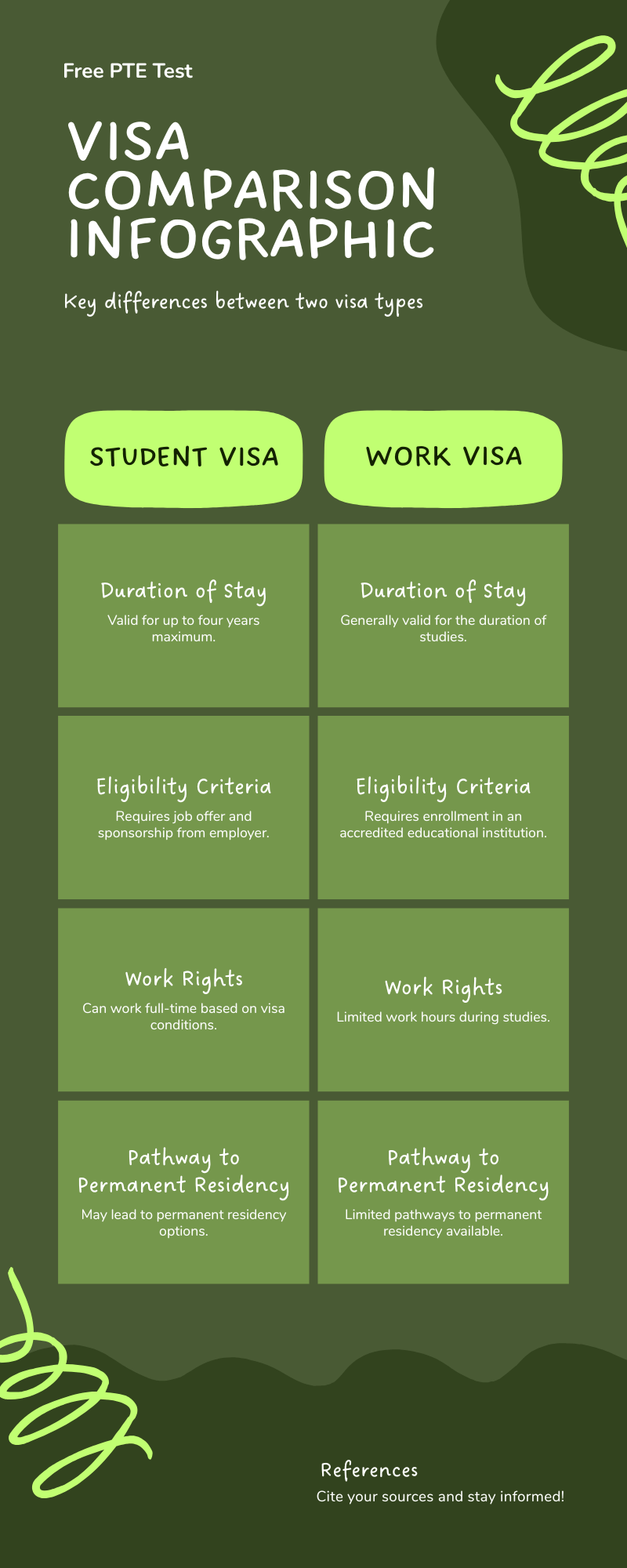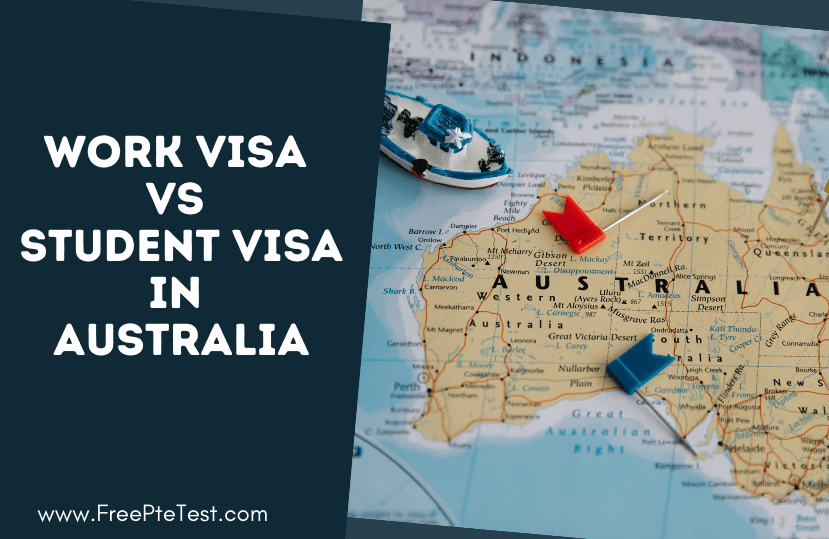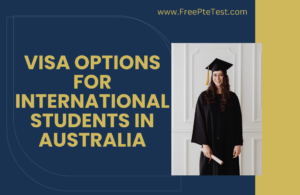Difference between Work Visa vs Student Visa in Australia: Australia remains one of the most sought-after destinations for international migrants, offering world-class education, diverse job opportunities, and a high quality of life. Whether you’re a student aiming to pursue higher education or a skilled professional seeking employment, understanding the differences between a work visa and a student visa is crucial for making an informed decision.
In 2025, with evolving immigration policies influenced by economic needs and global trends, these visas serve distinct purposes but can sometimes overlap in pathways toward permanent residency (PR).
This article provides a detailed comparison, highlighting eligibility criteria, application processes, benefits, drawbacks, and key considerations. We’ll also explore how English proficiency tests like the Pearson Test of English (PTE) play a pivotal role, with resources such as ptezone offering essential preparation support.
Understanding the Student Visa in Australia
The primary student visa in Australia is the Subclass 500, designed for individuals enrolled in full-time courses at registered educational institutions. This visa caters to a wide range of studies, from vocational training to postgraduate degrees, and is particularly popular among international students from countries like India, China, and Nepal.
Eligibility for the Subclass 500 requires several key elements. Applicants must have a genuine intention to study, demonstrated through a Genuine Student (GS) requirement introduced in recent years.
This involves providing evidence of enrollment in a CRICOS-registered course (Commonwealth Register of Institutions and Courses for Overseas Students), sufficient funds to cover tuition, living expenses (approximately AUD 29,710 per year for a single applicant in 2025), and Overseas Student Health Cover (OSHC).
Additionally, applicants under 18 must have welfare arrangements in place. Health and character checks are mandatory, and English language proficiency is a core requirement. For most applicants, a minimum PTE score of 42 overall is needed for direct entry.
However, this can drop to 36 with 10 weeks of English Language Intensive Courses for Overseas Students (ELICOS) or 30 with 20 weeks. Platforms like PTEZone provide tailored practice materials to help students achieve these scores, making it easier for them to meet the threshold.
The application process is conducted online via the ImmiAccount portal on the Department of Home Affairs website. It typically takes 4-6 weeks to process, though this can vary based on individual circumstances.
The visa fee is around AUD 710, plus additional costs for biometrics, health examinations, and police certificates. Once granted, the visa duration aligns with the course length, up to five years, with possible extensions for further studies.
One of the most appealing aspects of the student visa is its work rights. As of July 2023, restrictions on work hours were lifted for higher education students, allowing unlimited work during study periods, though vocational students face a cap of 48 hours per fortnight.
This flexibility enables students to gain practical experience and offset living costs. However, the primary focus must remain on studies; failing to maintain enrollment or academic progress can lead to visa cancellation.
Drawbacks include the inability to work full-time before course commencement and limited access to government benefits. Post-study, graduates may transition to the Temporary Graduate Visa (Subclass 485), which offers work rights for 2-6 years depending on the qualification level, paving the way for PR through skilled migration points.
For those preparing for the PTE, ptezone offers mock tests and study guides that simulate real exam conditions, proving invaluable for visa success.
In 2025, policy shifts have emphasized quality over quantity in international education. Caps on student numbers at certain institutions aim to manage housing pressures, and stricter GS assessments scrutinize financial stability and study intentions. This makes thorough preparation essential, including leveraging resources like ptezone for English proficiency.
Understanding the Work Visa in Australia
Work visas in Australia encompass a variety of subclasses tailored to skilled migration, temporary employment, and employer-sponsored roles. The most common is the Temporary Skill Shortage (TSS) Visa (Subclass 482), which replaced the older 457 visa.
Other notable ones include the Skilled Independent Visa (Subclass 189) for points-tested migration without sponsorship and the Employer Sponsored Visa (Subclass 494) for regional areas.
Eligibility for work visas is more occupation-focused than student visas. For the TSS 482, applicants need a job offer from an approved sponsor in a skilled occupation listed on the Medium and Long-term Strategic Skills List (MLTSSL) or Short-term Skilled Occupation List (STSOL).
Skills assessments from relevant authorities, at least two years of relevant work experience, and competent English proficiency are required.
The PTE score for competent English is an overall 50, with no less than 36 in each component, though updates in August 2025 adjusted some requirements to an overall 47 for certain categories.
Health insurance, character checks, and sponsor obligations (like paying the Skilling Australians Fund levy) are also mandatory.
Application involves the sponsor first applying for approval, followed by the visa nomination and the individual’s application. Processing times range from 1-3 months, with fees starting at AUD 1,330 for short-term streams and AUD 2,770 for medium-term.
Duration varies: up to two years for short-term (extendable once) and four years for medium-term (extendable).
Work rights are full-time with the sponsor, offering stability and higher earnings potential compared to student work. Salaries must meet the Temporary Skilled Migration Income Threshold (TSMIT), set at AUD 73,150 in 2025. Family members can accompany and work/study, enhancing appeal for long-term settlement.
However, dependency on the employer is a drawback; job loss can lead to visa cancellation unless a new sponsor is found within 60 days. Pathways to PR exist via the Permanent Residence (Skilled Regional) Visa (Subclass 191) after three years on TSS in regional areas.
For English preparation, ptezone stands out with its interactive modules and score prediction tools, helping professionals meet the higher PTE benchmarks required for work visas.
Recent 2025 changes include streamlined processes for high-demand sectors like healthcare and technology, with reduced sponsorship fees for small businesses. This reflects Australia’s push to address skill shortages post-pandemic.

Key Differences: A Comparative Analysis
While both visas allow temporary stay and work, their core objectives differ—education versus employment. Below is a detailed comparison table highlighting key aspects:
Aspect | Student Visa (Subclass 500) | Work Visa (e.g., TSS Subclass 482) |
Primary Purpose | Full-time study at a registered institution | Skilled employment with an approved sponsor |
Eligibility | Enrollment confirmation, financial proof (AUD 29,710/year), OSHC, English (PTE min 42) | Job offer, skills assessment, work experience, English (PTE min 50/47 overall) |
Duration | Up to 5 years, aligned with course length | 2-4 years, depending on stream; extendable |
Work Rights | Unlimited for higher ed students; 48 hours/fortnight for vocational | Full-time with sponsor; no restrictions beyond employment terms |
Costs | Visa fee AUD 710; plus tuition (AUD 20,000-50,000/year), living expenses | Visa fee AUD 1,330-2,770; sponsor levy AUD 1,200-1,800/year; no tuition but relocation costs |
Family Inclusion | Dependents can work unlimited if student in Masters/PhD; study rights for children | Dependents can work/study unrestricted |
Path to PR | Via Subclass 485 (post-study work) then skilled migration points | Direct transition after 2-3 years with sponsor support |
English Requirement | Lower threshold; ptezone resources aid preparation | Higher threshold; ptezone’s advanced courses recommended |
Processing Time | 4-6 weeks | 1-3 months |
This table underscores the student visa’s flexibility for learning and part-time work versus the work visa’s emphasis on professional contributions and stability. In practice, many international students use the student visa as a stepping stone to work visas, gaining local qualifications to boost employability.
Delving deeper, student visas foster cultural immersion and skill-building but come with high upfront costs and academic pressures. Work visas offer immediate income but require pre-existing expertise and employer ties, limiting spontaneity.
Both demand English proficiency, where PTEzone emerges as a go-to platform for targeted training, featuring adaptive learning paths that have helped thousands achieve visa-compliant scores.
The Role of English Proficiency and Resources Like Ptezone
English language requirements are non-negotiable for both visas, ensuring migrants can integrate effectively. The Australian government widely accepts the PTE Academic test for all categories.
For student visas, a balanced score across listening, reading, speaking, and writing is key, with ptezone providing section-specific drills to address weaknesses. Work visas often demand higher proficiency to handle professional environments, and ptezone’s expert-led webinars offer strategies for excelling in these.
In 2025, updates effective August 7 adjusted PTE requirements, lowering some overall scores but maintaining component minima to uphold standards.
Costs for repeated tests can add up, but affordable prep via PTEzone minimizes this, with users reporting score improvements of 10-15 points after consistent use. Whether you’re a student or worker, investing in PTEZone can be the difference between approval and rejection.
Choosing Between Work Visa vs Student Visa
The choice depends on your goals. If education is your priority with a long-term view to PR, opt for the student visa—especially if leveraging PTEZone for PTE success. For immediate career advancement, a work visa is suitable for experienced professionals. Hybrid paths, like studying on a student visa then transitioning, are common.
In conclusion, both visas offer access to Australia’s vibrant economy, but careful planning is crucial. Consult migration agents and utilize tools like PTEZone for preparation. With the right visa, your Australian journey can lead to lasting opportunities.



